WHAT IS
Modern Slavery and Human Trafficking?
Modern Slavery and Human Trafficking are grave human rights violations involving the exploitation of individuals through force, fraud, or coercion. Modern Slavery encompasses various forms, including forced labour, debt bondage, human trafficking for labour or sexual exploitation, child labour, and more. Victims are often trapped in situations where they're unable to escape due to threats, violence, or manipulation. Efforts to combat these issues involve international laws, awareness campaigns, and collaboration between governments, NGOs, and law enforcement agencies.
WHAT IS
Modern Slavery and Human Trafficking risk?
Modern Slavery and Human Trafficking risk refers to the potential vulnerability of individuals, communities, or industries to being exploited or victimised by these practices. Various factors contribute to this risk, including economic disparities, lack of education, unstable political environments, and weak legal protections. Industries that rely on low-skilled labour, such as agriculture, construction, and manufacturing, are particularly susceptible. Businesses need to assess and address these risks in their supply chains to ensure they are not inadvertently supporting or benefiting from these unethical practices. This involves due diligence, monitoring, and implementing measures to prevent and mitigate such risks.
WHO MUST CONDUCT A
Modern day slavery or human trafficking risk assessment?
Modern Slavery and Human Trafficking risk assessments are important for a wide range of organisations, especially those that operate globally or have complex supply chains. This includes:
WHAT RISK FACTORS SHOULD BE CONSIDERED WHEN CONDUCTING
Modern Slavery and Human Trafficking risk assessments?
Download our Modern Slavery Risk Fact Sheet
Download our Modern Slavery Risk and Control Module Brochure
Click on the button to download the Modern Slavery Risk and Control Module Brochure
COMPLETE THE FORM
Access the Content Module Overview
The content module overview provides an introduction to modern slavery and outlines the necessity and methods for its implementation.
Additionally, it presents the Arctic Intelligence Risk Assessment Platform, highlighting its potential advantages for your business.
Request your free copy now!

